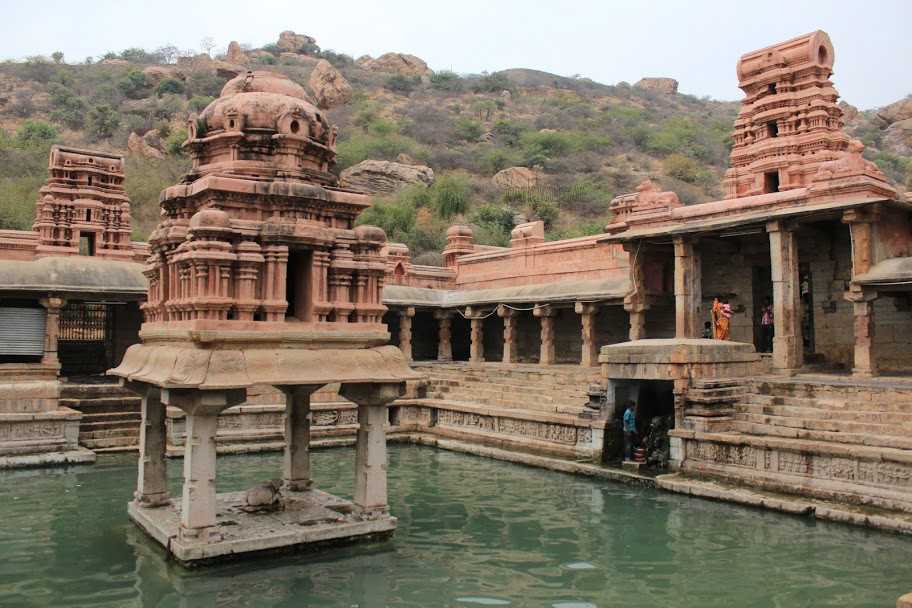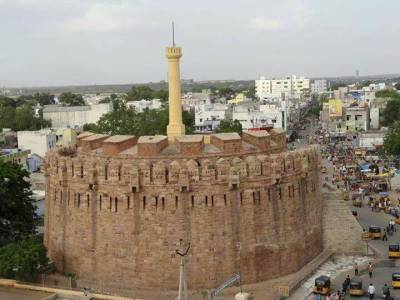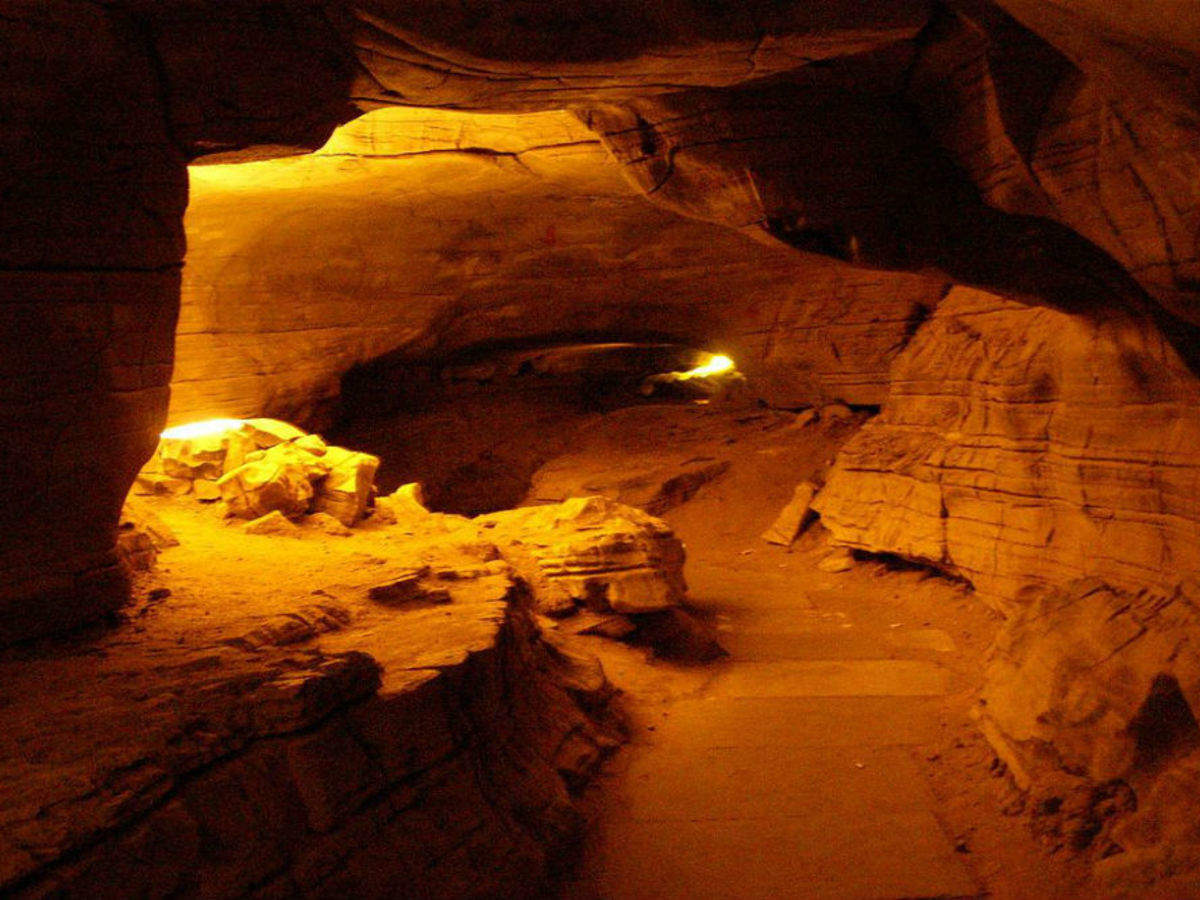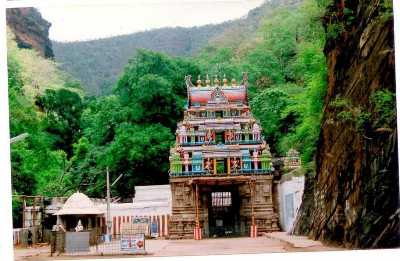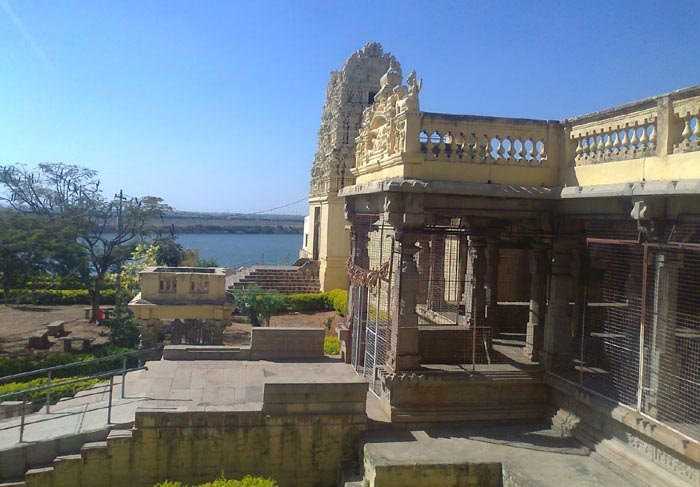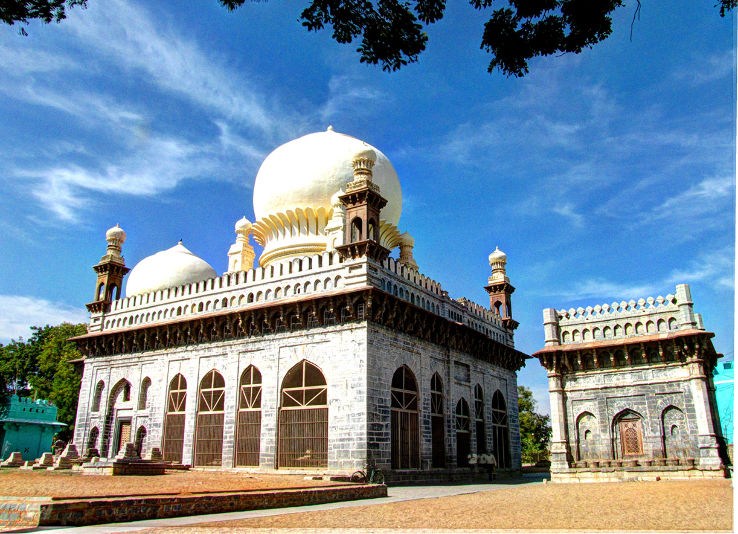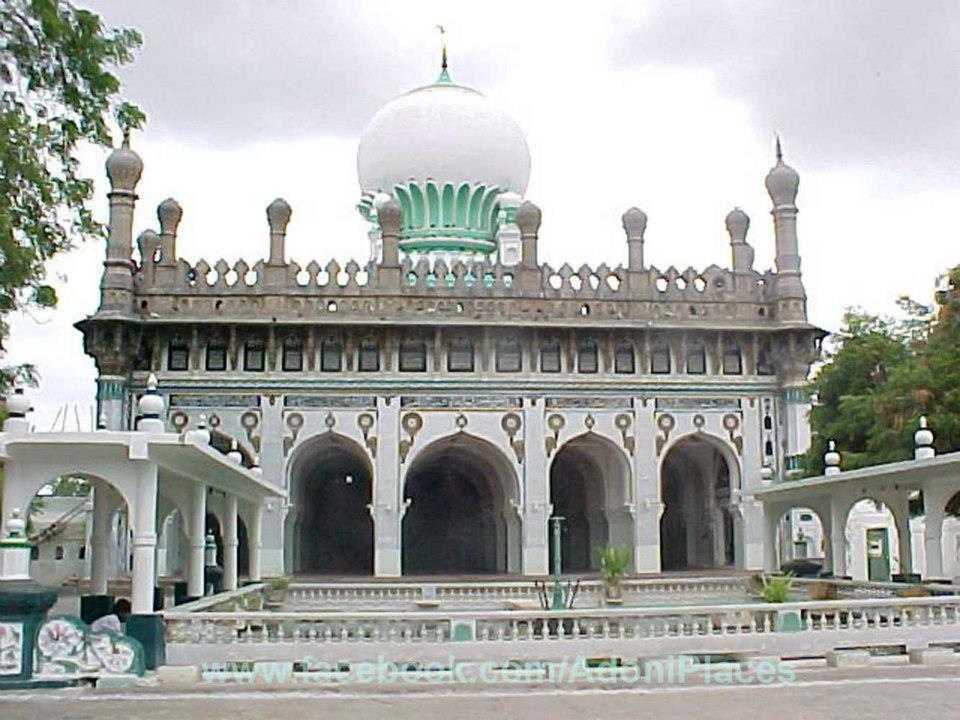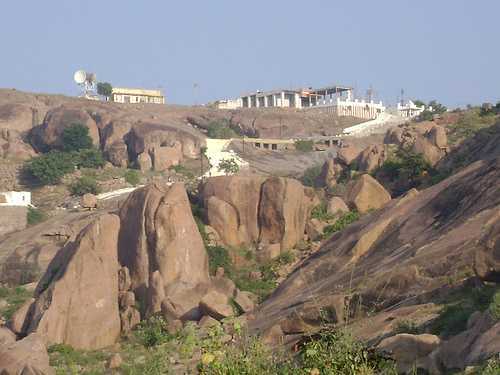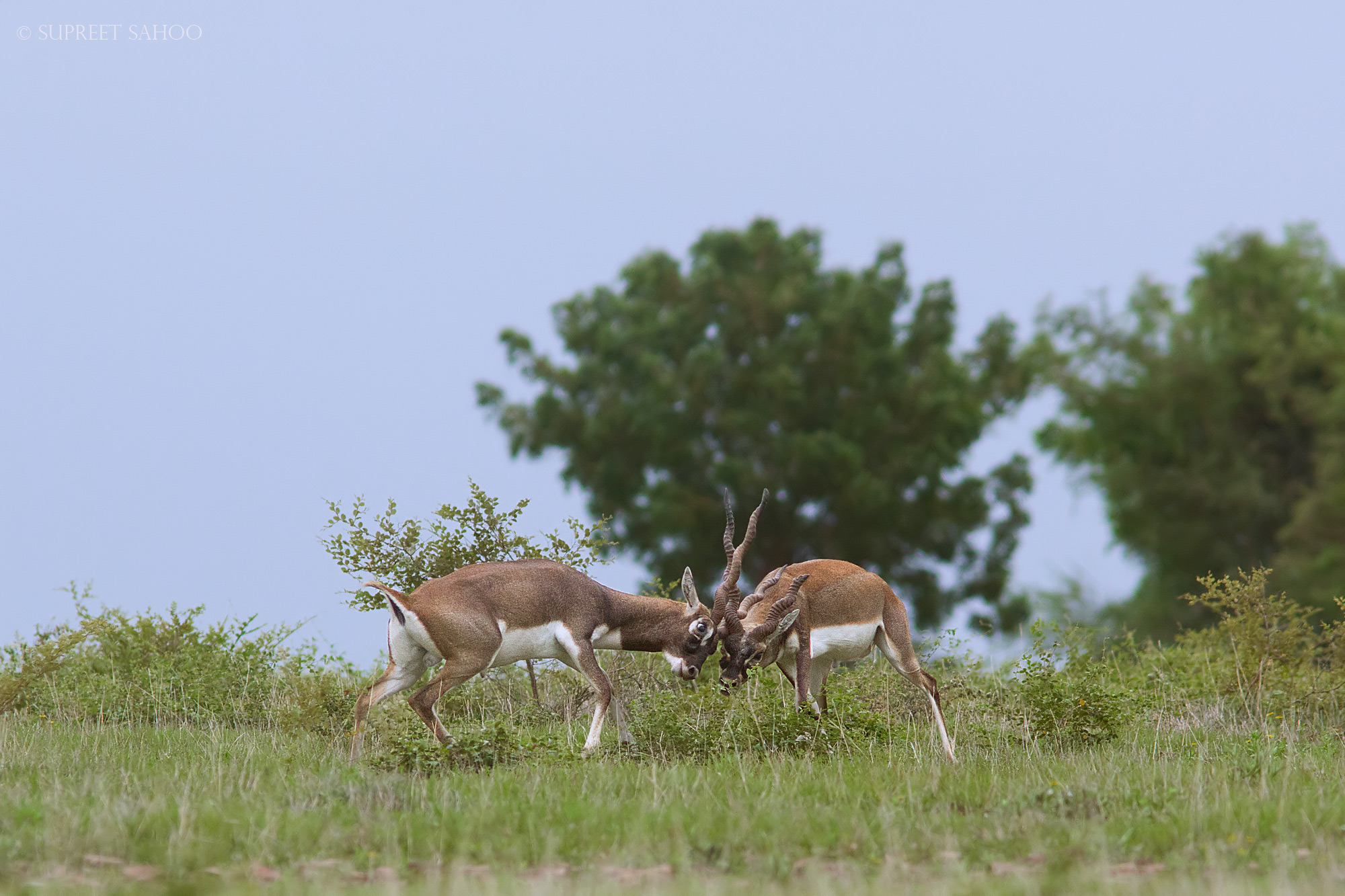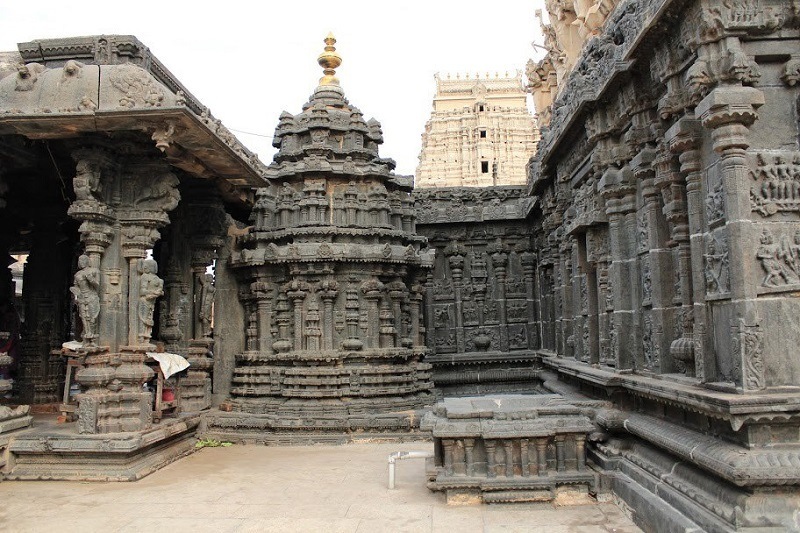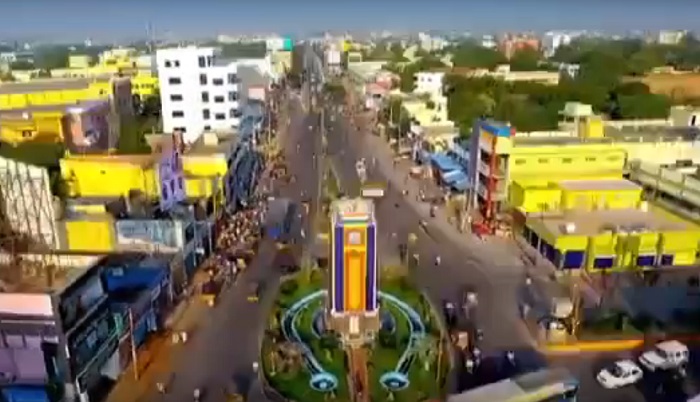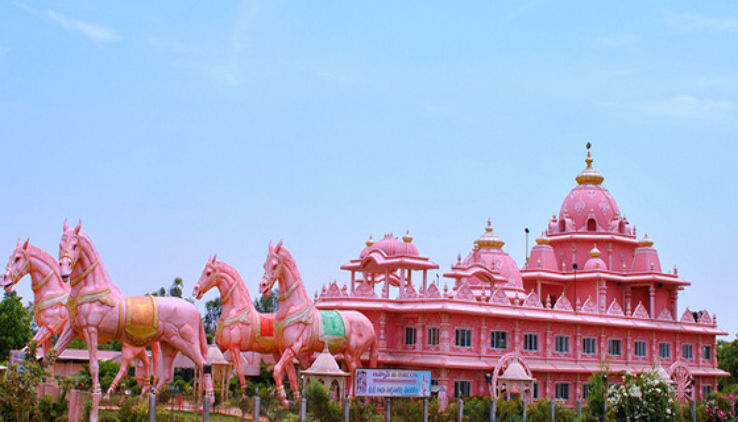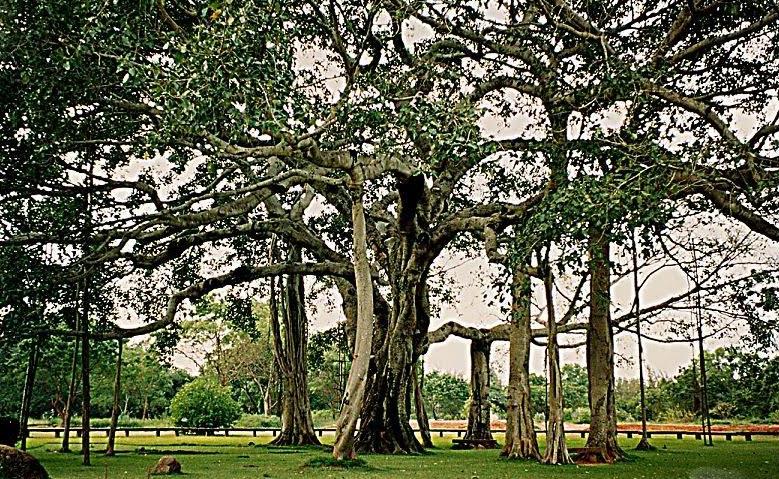After Guntur, Chirala, Nagarjunakonda, Srisailam, Cumbum and Nellore, let head south to tKarnataka.
Kurnool
The judicial capital of Andhra Pradesh, Kurnool is the state’s 5th largest city and is also known as the Gateway of Rayalaseema. Although the area has been inhabited for thousands of years, modern Kurnool was founded in the 16th century with the construction of the Konda Reddy Fort. Derived from the names Kandanavōlu or Kandanōlu, Kurnool used to be a crossing on the Tungabhadra River, where the bullock cart caravans are believed to have greased their wheels with kandana being a reference to grease. The Belum Caves have historical importance in the city as well as the Ketavaram rock paintings which are dated back to the Paleolithic era.
Yaganti, is famous for its temple of Sri Yagantiswamy, dedicated to Lord Shiva and is also known as the Uma Maheshwara temple. This ancient temple dates back to the 5th and 6th centuries and houses the idol of Shiva and Parvathi fused together, called Ardhanareeswara carved out of a single stone. The temple is not only of religious significance but also because it has many striking and unusual features. To begin with, Yaganti is perhaps the only temple dedicated to Lord Shiva, where he is worshipped in the form of an idol, instead of the Shiva Linga. The temple also has the Agastya Pushkarni, where water flows from the bottom of the hill, throughout the year. Worshippers take a dip in the holy water as a form of worship to the deity. There are different stories revolving around the origins of the temple. According to one story, the sage Agastya wanted to build a temple for Lord Venkateswara here but for some reason, the statue of the Lord could not be installed be here, and the sage then penanced for Lord Shiva. When Lord Shiva appeared, the sage realised that the place suited him better and then requested Lord Shiva to appear in the Ardhanareeswara form, to which he obliged, and which is present form worshipped here. According to a second story, when a devotee of Lord Shiva, known by the name of Chitteppa, was worshipping the Lord, the latter appeared to him in the form of a tiger. Chitteppa recognised that it was Lord Shiva in the tiger form, and he exclaimed Neganti Shivanu ne kanti, which means I saw Shiva. . The festival of Maha Shiv Ratri which falls around October or November each year is celebrated with great pomp and show at the temple. The numerous natural caves in the hills around the temple were home to several saints throughout the ages, prominent caves include the Agastya cave, which is believed to be the place where saint Agastya performed penance to get Lord Shiva’s blessings; the Veera Brahmam cave, the site where Potuluri Veera Brahmam, who is known as India’s Nostradamus, wrote some chapters of his prophecies in the Kala Gnanam and the Venkateswara Cave. All these caves are open for worship from dusk to dawn. A fantastic feature of the temple is its Pushkarini, a water stream with very pure water with no one being able to figure out the exact reason of how the water flows into Pushkarini in all the seasons and a bath in the holy Pushkarini before visiting Shiva is considered to be highly beneficial. Also according to legend, crows do not fly in Yaganti because when sage Agastya was meditating here, Kakasura, the king of crows had disturbed him from his meditation. The sage, in turn, cursed the crows not to enter the premises and since the crow is considered the vehicle of Lord Shani, he cannot enter the temple. Perhaps the most famous legend associated with the temple, is the growing Nandi. Not just a belief, by documented by the Archaeological Survey of India which says that it is because the rock has a growing nature associated with it.
Konda Reddy Fort, also known as the Kurnool Fort or Kondareddy Buruju, is located 2 km from Kurnool railway station. In ruins today, the structure was built by the rulers of the Vijayanagar Empire. The modest looking structure, once housed a tunnel that passed from under the Tungabhadra river and still holds a majestic watch tower, looking over to the city that grew around it.
The Adoni Fort is a 15th century monument built during the reign of the Vijayanagara dynasty and served as a military base with its walls stretching over 50 km making it the largest fort in the country. After the downfall of the Vijayanagara empire, the fort was in the possession of the Bijapur Sultanate and later, after the defeat of Tipu Sultan, came under the British rule.
The Belum Caves are black limestone caves which are the largest and longest cave system in India famed for their unique formations such as stalactite and stalagmite formations and formed over many million years. A centrally protected monument of national importance, the Belum Caves has numerous pathways with intricate patterns of water streams on limestone. One of the most striking features of the cave is the stunning rock formations called Saptasvarala Guha (the chamber of seven notes). Here, you can hear the musical sound when struck with the wood, bamboos or knuckles. Simhadwaram, which means doorway for gods is a breathtaking archway giving an illusion of a lion’s head. The Kotilingalu Chamber contains thousands of naturally made lingams. The lingams are formed of stalactites. Voodalamari is another stalactite formation resembling a banyan tree. Thousand hoods, yet another stalactite formation is shaped in the hood of thousands of cobras. Dhyan Mandir is an interesting rock limestone formation shaped as a bed with pillow, local legend suggests this place was used as the meditation centre by all saints. Today more than three and a half km of the cave has been successfully explored of which only a kilometer and half is accessible to tourists. In some places, the depth of the caves goes as deep as 46 m, this point is known as Pataalaganga. An underground stream flows all year at this point, gliding over the rocks and hiding beneath the surface again. The cave consists of various long passages, galleries, large cavities with fresh water and water tunnels and three spectacular sinkholes. A major structure of the caves is dedicated to the period when it was invaded by the Jain and Buddhist monks. Evidence of the Jain and Buddhist remains have been found in the caves. A meditation den, saint’s bed, and several relics were discovered from the cave. Few relics found inside the caves could be dated back to 4500 BC. An enormous forty feet high statue of Lord Buddha was installed outside the caves to commemorate the roles of monks in the caves. The base of the statue consists of a lotus which also has a huge room within but does not have such a good condition. The caves are open from 10 am to 5 pm with Indians paying INR 50 and foreigners INR 300 as entry fees.
A scenic village, Mahanandi is surrounded by dense forestation with the Nallamala Hills located to its west. The village has one of the nine shrines dedicated to Lord Nandi, also called Nava Nandulu and famous for a 10th century ancient temple, the Mahanandiswara Swami temple which draws pilgrims every year on the occasion of Mahashivratri.
Dedicated to Lord Narasimha Swami, the Ahobilam or the Nava Narsimha temple is the only temple where all the nine forms of the deity are worshipped. Ahobilam is believed to be the middle of Adishesha who expands all over the Nalmalla Hills. The temple was built according to the Vijayanagara style of architecture and houses idols of all the nine forms of Lord Narasimha Swami. The temples are are distributed all over the hill and have idols of the deity in their respective forms made of stone and most devotees cover all the temples in one trip to the region.
The Sai Baba Temple located on the banks of the river Tungabhadra is a beautiful star-shaped structure with a traditional Shikhara in the centre on the top. The sanctum sanctorum has an idol of Sai Baba made of pristine white marble. The complex also houses a meditation hall that can accommodate about 800 people.
The Sri Mahayogi Laxmamma Avva Temple is dedicated to Lakshmamma, also known as Avva. She was born in a poor Dalit family, had nothing to live off of and was considered insane because she was always found muttering to herself. Some believed in her powers and offered her food and clothing till she was alive. According to a legend, Avva’s limbs were mutilated but the next day she was seen doing her regular chores and after many such miracles she has been considered an avadhoot.
The Sri Ranganayaka Swamy temple is an 18th century temple built by Krishnadvaraya of the Vijayanagara dynasty who wanted to build a temple similar to the one he visited in Srirangam. He later dreamt of Lord Vishnu telling him that an eagle will direct him to the location where the temple must be built and the beautiful Vijayanagara structure is an architectural treat.
An important pilgrim centre dedicated to Goddess Saraswati, at the Kolanu Bharathi Saraswathi temple the century-old tradition of Aksharabhyasam is performed at this ancient temple. It is also considered to be the abode of Goddess Sri Bharati. The temple complex also has a Shivalinga, known as the Sapta Linga Kshetram, and a statue of Kaala Bhairav who protects the region.
A 19th century shrine dedicated to Lord Satyanarayana, the Satyanarayana Swamy temple is famous for its splendid architecture with a magnificent entrance and beautiful bas-relief and sculpture work on the gopuram.
On the banks of River Handri is a 17th century structure known as the Tomb of Abdul Wahab. A monument with elaborate workmanship, two majestic domes, verandahs, arches and more, the tomb was built after the death of Abdul Wahab Khan, the first Nawab of Kurnool. The tomb located near Osmania college and also known as Gol Gummaz as it slightly resembles Gol Gumbaz of Bijapur was recently renovated and is now in a much better condition.
The Jumma Masjid in Kurnool is a 17th century mosque built by Madu Qadiri who was a governor under Adil Shah. The splendid architecture of the mosque includes beautiful minarets, magnificent domes and spacious prayer halls making it a tourist attraction as well.
The Nallamala Forest is over a vast region of the Eastern Ghats and is home to a wide variety of flora and fauna including antelopes, neelgais, chinkaras and leopards. The forest area also includes the Nagarjunasagar – Srisailam Tiger Reserve. The natural landscape, the dense forestation with several stupendous waterfalls and other water bodies, make the attraction perfect for nature lovers.
A park with igneous rock formations, the Oravakallu Rock Garden has a restaurant, small ponds, boating facilities and a cave museum.
Ranamandala Konda is a religiously important attraction in the region as it is believed, this was the place where, during their exile, Lord Rama shot an arrow and it formed a lake to provide water to Goddess Sita. This is also where Lord Hanuman is believed to have fought demons while Rama was sleeping to ensure he doesn’t get disturbed. The attraction also has the famous Ranamandala Anjaneya Swamy temple which is a shrine with no roof.
A wildlife sanctuary spread across an area of 614sq kms, the Rollapadu Wildlife Sanctuary offers its visitors a journey into the wild, close to nature, amidst a number of diverse species of flora and fauna. Established in 1988, Rollapadu is especially known for being the home to the endangered species of the Great Indian Bustard and Lesser Florican. The wildlife sanctuary, spread across the huge area is the home to many birds and reptiles. With the Rollapadu village nearby, a man-made water reservoir, preserved for the consumption of wildlife, another reservoir for the collection of rainwater, Rollapadu Wildlife Sanctuary also sets a very good example of the mutual coexistence of mankind and nature. The sanctuary is open from 7 am to 6 pm.
Mantralayam
A holy town, Mantralayam is located 74 km from Kurnool on the banks of the Tungabhadra river near the border with Karnataka. The town is known for Sri Guru Raghavendra Swami, a follower of the Vrindavant cult of Lord Krishna and a saint who entered into a samadhi alive in front of his disciples in the 17th century, a Madhwa saint who is considered to be a reincarnation of Prahlada who was a daitya king saved by Lord Vishnu’s Narasimha avatar. The temple and the Mutt complex are the main attractions here. The temple elephants and chariots carrying the deity around the temple on special occasions are spectacular as is the Tungabhadra river. The temple is open from 6 to 8:30 am, 9:30 am to 2 pm and between 4 to 9:30 pm though the best time to visit is during the evening aarti at 7 pm. Other sites worth visiting in the vicinity of the complex are the Panchmukhi Anjaneya Temple, the Lakshmi Venkateshwara Temple & the Vedic Pathshala or school.
Gandikota
Known as the Grand Canyon of India, Gandikota is a small village near Kadapa flanked by the Pennar river on the right. The village is popular for the spectacular gorges formed by the river cutting through the Erramala hills. The narrow valleys with streams running between them and the steep rocky walls to give them company remind one of the Grand Canyon and requires a walk of almost a km from the main gate to reach the boulder from where you can observe the mesmerising view from the viewpoint near the fort. Located 1.5 hours away from the Belum Caves, the ruins of the Gandikota Fort built in the 13th century and flanked by the Pennar gorges on both sides and protected by a majestic 5-mile wall is spectacular. Built in red sandstone, the fort boasts of beautiful, intricate carvings in the interior. It also offers sweeping views of the hills and valleys below. In addition to a granary, jail and ruins of some temples, there are several structures within the fort that one can visit. The Raghunathaswamy temple is a unique temple inside the Gandikota Fort housing no idols but has airy corridors, complex hallways and is flanked by an array of towering pillars. The Madhavaraya temple on the other hand, has several idols and is a living masterpiece of ancient architecture. Boasting of several sculptures, the temple is a local favourite. The beautiful Jumma Masjid mosque situated within the premises called the Jamia Mosque, has a beautiful architecture, similar to that of the Charminar mosque in Hyderabad and is a popular camping spot because of the green cover in the vicinity.
Tadipatri
An ancient temple town, Tadipatri was built during the golden years of the Vijaynagar empire. The Chintala Venkataramana temple is home to numerous, yet rare imagery of gods and their sculptures. Walking inside will reveal to an image of Lord Vishnu with multiple arms. This image of the deity is supposed to take on the forms of many other gods, such as one set of hands showing Lord Ram with a bow and arrow, while another set of arms shows Lord Krishna with a flute he. Built-in the shape of a chariot, the Chintala Venkataramana temple’s shrine dedicated to Garuda is made out of granite and carved with great detail. And it is similar to the Vittala Temple at Hampi which holds the Garuda mandapa. A protected heritage site from the 16th century, it is believed that the Bugga Ramalingeswara temple had been constructed between the years of 1490 and 1509 and is without any doubt, a must-visit for everyone. As one enters the temples, they are greeted with skilfully carved sculptures, towering gopurams and musical stone pillars. Sunsets are amazing with the temple as a backdrop. The temple is very distinct because of the occurrence of a natural underground spring, from where water creeps into the Garbha Griha. The water automatically drops onto the place where the Lingam is installed. It is believed that Saint Parasurama lived here and did extensive meditation here. The entire Shiv Purana is written on the temple walls. A beautiful village and mandal located within the heart of Bathalapalli, Anantasagram is a destination for nature lovers because of the huge amount of greenery and water from the riverbanks.
Anantapur
A town in transition, Anantapur is at the confluence of the past and the future and reverberates with flashes of India’s glorious history and the true ethnic traditions and values. Anantapur also receives the second-lowest rainfall in India. It is said that the place has derived its name from Anaatasagaram, a big tank, which translates into endless ocean. Chikkavodeya, the minister of the Vijayanagar King, Bukka-I constructed the town of Anaatasagaram and Bukkarayasamudram.
Like all other ISKCON temples, the one at Anantapur, located at Somaladoodi village on the outskirts of Anantpur, is just as beautiful. The temple is in the shape of a horse-drawn chariot, with statues of four huge horses at the entrance. This temple is known as the Radha Parthasarathi Temple and was inaugurated in February 2008 and has a restaurant attached to it. The beautiful temple looks even more scintillating at night when lights illuminate its walls. The most cherished festival is Janmashtami, the birthday of Lord Krishna. The temple is open daily from 4 am to 12 noon and from 4:30 to 8:30 pm.
A recent addition, the Hanuman statue at Mounagiri is built several feet high and can be seen from several km afar as well as a temple, for those who wish to pray. The 37 feet tall Hanuman statue is made up of a single stone and was completed in the year 2010.
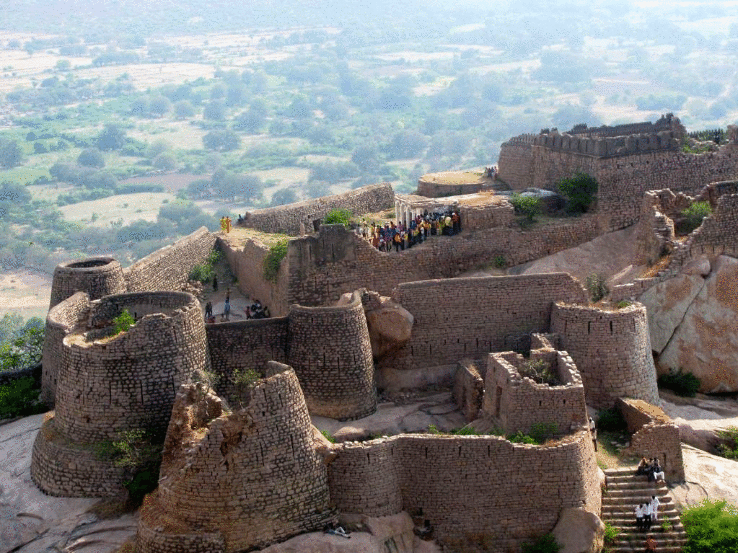
The Penukonda fort is located at a distance of nearly 70 km from Anantapur. Previously known as Ghanagiri, the name of the fort is derived from the word Penukonda, which literally means big hill. This historic fort was once the second capital of the Vijayanagar empire. According to archaeologists, the fort was built by Vira Virupanna Udaiyar’s rule, the son of King-Bukka I of Vijayanagar. A huge idol of Lord Hanuman is placed inside the fort. The 11-feet tall Penukonda Fort houses multiple mosques inside among which the Sher Khan Mosque is the most important. The Gagan Mahal, a palace inside the fort, was built back in the 16th century. Another palace, the Babayya Darga was constructed to symbolise harmony between Hindus and Muslims.
Situated 300 meters above sea level, the Gooty fort is one of the oldest hill forts in the state and the country. The name Gooty is derived from the town’s previous original name, Gowthampuri. Having been designated as a monument of national importance, the fort has been the stronghold of the Chalukyas, Mughals, Marathas, East India Company as well as the Vijayanagara empire before the Qutb Shahi dynasty took over. It is mentioned as the King of Forts according to various historical inscriptions found here. The mammoth Gooty Hill covers a vast area is surrounded by the town on three sides and the westernmost point housing the citadel of the fort. The ruins of the fort are dotted by numerous different buildings and spaces such as granaries, bastions, gunpowder magazine, ramparts, storerooms and temples. The fort is open daily from 9 am to 6 pm and there is no entry fee.
The Anantapur Clock Tower is the landmark in the town innagurated in 1947 and stands 71 m tall in the middle of the town and is well maintained.
Thimmamma Marrimanu is a huge banyan tree located at about 70 Km from Horsely Hills. This historical Marrimanu tree is has been preserved since ancient times with the word marri meaning banyan and manu meaning tree in the Telugu language.
Puttaparthi
The holy abode of the Sathya Sai Baba, Puttaparthi is a town which takes you back to the days of ashrams. A tiny town, Puttaparthi has gained global fame as a religious centre offering modern approaches to religion, for being a unique village with urban facilities. Though Puttaparthi does not have many natural marvels or traditional tourist attractions, its richness and substance lie in its spiritual significance.
The main attraction here is the Sathya Sai Ashram known as Prashanti Nilayam, literally translates into the abode of peace. In the ashram one finds sprawling and beautiful educational institutions, stadiums, museums, hospitals and all the modern facilities capable of accommodating thousands of devotees at a time. The most discernible part of this ashram is the assembly hall where Sathya Sai Baba used to give his darshan. Inside the ashram is a banyan tree which was planted by by Sai Baba himself and is a silent zone for meditation in the ashram and is known as the Meditation Tree. A thick metal plate placed at the root of the tree is said to be joined by Sathya Sai Baba to boost the spirits amongt those who meditate here. The area is divided into separate parts for men and women. However, women are not allowed to visit before sunrise and after sunset for safety reasons. It is also believed that banyan trees have the power to purify the air all around, making the environment of the ashram all the more pristine. There is also an old tamarind tree in the ashram known as the Wish Fulfilling Tree. It is believed, that as a kid Sai Baba would take his friends up to this tree and ask them to think and wish for any fruit that they want to have, and the tree would give theme the same. The tree is located on the slope of a hill shadowing the Chitravathi river below.
The Shiva temple stands today where birthplace of Sathya Sai Baba is believed to be. One of the significant religious centre of the town, the Anjaneya Swamy Temple, dedicated to Lord Hanuman, houses a Siva Linga, believed to be brought by Sathya Sai Baba from Kasim, and a beautiful deity, which too shares a legend with Sathya Sai Baba. It is believed that as he was about to carry out the ritual of walking around the diety to worship and pay respects, the diety stopped him by saying that it is it, who should pay respect to him instead. At the foot of this deity one finds a pool of water which devotees believe to depict Lord Hanuman’s tears as his devotion to Lord Rama. The only temple in India dedicated to Sathyabhama, a lover and consort of Lord Krishna is here in Puttaparthi. The beautiful temple finds its origin to a dream that Sai Baba’s grandfather had where Sathyabhama appeared and asked him for an abode. The temple is adorned with various images of Lord Krishna. The Gopuram is a large and decorative gate devoted to Ganesh the elephant god. Built in 1975 as a birthday commemoration to Sai Baba, the gate is adorned with many multi-colored idols and stands over the entrance to his Ashram. Close to the Gopuram, is the Samadhi shrine, a cenotaph dedicated to Sai Baba’s parents. Morning prayers are carried here between 9:30 am and 11:30 am and the evening prayers are carried out between 4:30 and 6:30 pm. The area is also the site of an annual festival observed on Easwaramma Day, that is the death anniversary of Sai Baba’s mother. The festival is carried out with bhajans and special prayers and distributing food.
One of the most beautiful structures in Ashram, is the Chaitanya Jyoti Museum, which houses all stories and incidents of the life of Sai Baba, all the way from his early childhood. Visitors are introduced to the godliness and divinity of Sai Baba through multimedia presentations and more. The structure too, is a specimen of fine architecture and design which combines Chinese roofs, Moorish Spires, Gothic arches and Japanese and Thai styles. The museum was designed by a NASA scientist, Art-ong Jum Sai.
Inside the Ashram, one also finds a fascinating Planetarium known as the Sri Sathya Sai Space Theatre which on every Thursday conducts a show on space and astronomy with the idea to educate and create more awareness amongst the masses about the disciplines of Physics, Astronomy and Mathematics. There is a Spitz Space System which is used to get some amazing views of the night sky. The theatre can hold a maximum of 200 people at a time and tickets for the shows are given on a first come first basis. The show is available in both English and the Hindi, with the English show taking place between 10 and 10:45 am and the Hindi one between 11 and 11:45 am.
Close to the University in the ashram is the Spiritual Museum which showcases the foundation of one of Sai Baba’s main teachings, that is the unity of religions. The museum is constructed in a Shikhara style of architecture and the design also derives inspiration from North India’s Jain temples. The museum holds replicas, idols, artifacts and other instances of religions from all over the world. It also depicts and displays teachings of a number of saints and major religious convictions.
In our next part, which is the last one, we see Lepakshi, the hill station of Horsley Hills, the town of Chittoor which is a blend of old and new and the temple towns of Srikalahasthi and the world famous town of Tirupati


